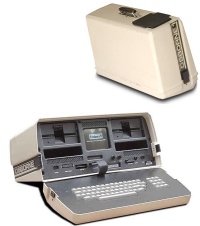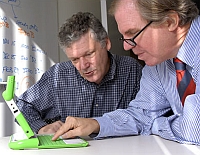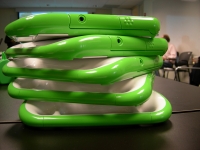A few days after the 1906 earthquake and fire that devastated San Francisco Larry Harris, a local writer, turned out a poem that was widely printed. Entitled "The Damndest Finest Ruins", it contained the phrase "...where the buildings that are standing sort of blink and blindly stare/ at the damndest finest ruins ever gazed on anywhere."
So we now gaze at the ruins of the OLPC project as originally set forth by Nick Negroponte. As my writings since 2005 make clear, I never had any doubts that the program would fail in its stated aims.
My concern was always with what would happen in the aftermath of the collapse. My worst-case scenario had the whole idea of computers in the hands of people at the grassroots level in the developing world discredited ("we tried that and it didn't work"), and funding denied to or withdrawn from a number of projects which had nothing to do with the OLPC approach.
Fortunately, things have developed in such a way that this outcome is highly unlikely. This is because, through the improvised G1G1 program, tens of thousands of XO machines have gotten into the hands of computer-skilled enthusiasts in the developed world. Also, despite Dr. Nick's fulminations ("screw you!") against pilot projects, several locally-based pilots have gotten under way in, among other places, South America and Nepal.
While these are hopeful indications, they are not enough to justify unbridled optimism. Without a significant influx of coordinated effort the results will, in my opinion, have little effect outside the pilot areas. Considered as a project meant to bring about significant improvement in education worldwide, OLPC is in ruins (if it ever was more than a laptop development project).
A history of technology "ruins"
Ruins, but perhaps the "damndest finest ruins" yet seen in the personal computer area. For the development of the whole industry is a story of success built upon ruins - ruins of companies, ruins of product plans, and ruins of technologies. Sir Harold Evans, in his book "They Made America", points out that Gary Kildall made the personal computer important by pioneering the CP/M operating system that allowed interoperability of software.
Thus, the value of work expended in software development would survive the demise of the company within which the work was done. The flexibility this provided made all the difference in the triumph of the decentralized microcomputer industry over the hugely well-funded structures of the big companies.
When designing the Osborne portable computer I was directed to use 5 inch video displays. It turned out that these display components were developed for the IBM 5100 (a BASIC and APL desktop machine taken out of production the year before) and were thus available from three manufacturers with compatible mechanical and electrical specifications.
They were junk - leftover products without a home - but their development had been paid for by IBM's customers. Three years later the Osborne computers were junk - the company bankrupt - but a lot of software developed for it shifted over to the IBM-PC.
I probably need to point out here that this is much different from the way things happened in the computer industry prior to the personal computer. IBM made computers with components manufactured by IBM, installed them with technicians trained and paid by IBM, and wrote the software in house with IBM "systems analysts". Computers were leased, not sold. This was the industry model hewed to by all participants.
There was a business in "plug-compatible hardware", mostly storage systems like disc drives, but it had to grow under attack from the mainframe manufacturers' lawyers. Systems were mutually incompatible. Altogether, this system had the effect of preventing any company from benefitting from the work done at any other company.
The developers of personal computers took an entirely different path, mostly because they had no money and had to find a way to stand on each others' shoulders rather than toes. Amusingly, even though the founder of the company producing the first PC (MITS' Altair) made blustery statements about how he would not tolerate other companies making plug-ins to his computer, it became glaringly obvious that he needed the other companies' plug-in products to make his product viable.
Product lifetimes were often longer than their companies' lifetimes. There was enough room for improvement that compatible improvements were easy to create. The Altair itself was superseded by the Imsai, a competitor's machine that was fully compatible and built to industrial standards. The plug-in cards facilitated competitors' compatible products. The winners were the application software developers and with them, the users.
The foundation of OLPC's ruins
What is the relevance of this history to OLPC? Well, the project began as centralized as an IBM product development. Brilliant minds in Cambridge would turn out a laptop that could only be described as magical, as through mere possession it would cause an entire generation to rise above its circumstances, "learn learning", and achieve something presumably like satori. Actually, that previous sentence should probably have ended with a three-dot ellipsis halfway through, as the conclusions were implied more than stated.
My point is that the project was functionally indistinguishable from a commercial product development effort targeted at governments. Any attempt to begin a critical dialogue examining the premises of the project and the reasoning by which the conclusions were reached ran into a dead end. OLPC was definitely not a "hands-on" project.
Yes, third parties could develop software that ran on the XO, but such software would benefit no one other than the project and, supposedly, the children with the XOs. But without the opportunity for pilot projects it would have been impossible to develop software having the intended effect - once again, superior minds would have to turn out brilliant products from ivory towers.
It just doesn't work that way - not after the decentralized, interactive, networked personal computer industry overwhelmed the dinosaurs of the mainframe computer industry. There's no going back. Resistance from the education ministries, not held in thrall by the abstract concept of technology, proved the downfall of the OLPC grand plan.
The reaction, in the form of the "give one, get one" (G1G1) program moved the product to some degree, but also put thousands of XOs in the hands of prospective software (and hardware) developers, whetting the appetite for participation in the development of actually workable software and systems.
The limited nature of the G1G1 programs made its failure inevitable. Appetites, once whetted, must be satisfied or the result will be negative. Any reader of OLPC News will be familiar with tales of the impossibility of obtaining a quantity of XOs suitable for a pilot test. So the project, unable to get the size of orders necessary to justify the pricing and denying itself the opportunity to make use of the creative efforts of its fans, crumbled into a hardware laptop project having less and less distinction from the "netbooks" that it had caused to come into existence. As a final blow we are told that it was never about education but about volume production.
Building on OLPC's ruins
OLPC lies in ruins, as we said above, but oh, what ruins! The hardware development effort was excellent (for the laptop - not so much for the chargers and networking services). Mary Lou's display was a real advance in display technology, promising greatly reduced cost along with greatly improved performance - not a tradeoff, but a trade-up. Marvell's mesh networking chip shows great promise if matched with drivers and software that make use of its capabilities.
And any hardware designer can tell you a multitude of tricks that can be used to reduce power consumption - provided that you do not have to be a slavish imitator of XP notebooks.
These are ruins you can build upon. What will be necessary is to abandon the concept that it must all be done from one place, under one guiding vision. Every one of us has a piece of the vision, in fact of a multitude of visions, and we can put these pieces together if we leave behind the idea that there is one right way. Port Sugar to netbooks, to start with. Get together with education geeks to dream up pilot projects that can be done with such netbooks, then use every available channel to put the pilot into effect. Communicate across disciplinary boundaries and draw into the discussion people who have good ideas but lack the means to implement them.
Create tiny markets out of nothing, selling to each other, and grow them whichever way works. These markets will gain respectability as they develop, and their existence will put an end to talk about how it can't be done (there will be an intermediate stage wherein it is admitted that while it can be done, the numbers show it is insignificant).
Wherever there seems to be a bottleneck it will be necessary to figure out ways to bypass it. Someone will have to explore channels known only to those who deal with Asian manufacturers to find out how much of the existing XO-1 design could be produced, under what circumstances, and within which time frames. Such information is not published and the companies prefer to deal with people with whom they are familiar. Still, a good deal of money went into setting up the manufacture of XOs and the manufacturers might want to see some return from it
Even if such arrangement cannot be made right now, do not underestimate the power of a well-written specification that proclaims "if someone built this machine, we could put the pilot software on it and deliver the results we have demonstrated, and someone could make a good deal of money". The XO-1 can serve as a prototype for whatever is to come when someone follows the recipe entry to "add money and stir".
OLPC has succeeded in doing what most of us in the personal computer industry did - generate a rich set of tools and subsystems available for use by anyone. Some may pass it by saying "there's no viable business there - just a junkyard". Others will look at it and say "we could make a viable business out of the opportunities presented by what's in this junkyard."
They will be looking at "...the damndest finest ruins ever gazed on anywhere", and not just dumbly staring. San Francisco rose reborn from its own ashes in a remarkably short time, enshrining a can-do spirit that attracted the innovators of Silicon Valley among many others. These are the sort of people who will see the possibility in these ruins.






ruin? you did hear about india, right?
this is FUD.
Maybe we should wait until the check clears. Politics, and government-funded education is at base political, is directed by the most powerful influence. What's the constituency that's directing funding towards the OLPC?
I think Lee is looking at the big picture - remember Negroponte promised 10 million Xo's and he's no where near that even with India. Also, remember the refocusing? OLPC is hurting, no matter the recent good news.
the times aren't good for anyone at the moment.
again this is just olpcnews being the harbinger of doom and gloom. the fact that the G1G1 program is mentioned so heavily in this article just shows that the author does not understand the OLPC idea.
besides this is not "news" this is "opinions", i think olpcopinions.com is still available.
Well OLPC hasn't been doing anything newsworthy lately. New designs are nothing but rumours, Sugar is sitting there making SoaS that doesn't even work on XO hardware, and is as unstable as ever. No real news or studies on deployments.
We need something to generate content.
Hola!
Where do we get batteries for our XO after our Lithium batteries die after 3 years of use?
Simple question!
Parts are not available unless you buy another XO to use as the source. When all the batteries are beyond 3 years old, then where are they available?
http://xoexplosion.com/index.php?main_page=product_info&cPath=16_37&products_id=119
@ha!: FUD or "doom and gloom" this is not. I'm making an optimistic statement, based upon history, about how OLPC fans can actually implement the goals they seek, while making money and having fun.
@GregYohn - looks like a business opportunity there! Simple question indeed, but it leads to a not-so-simple process that others have successfully implemented. Hint - it's best if the supplier can get OLPC's co-operation in making specifications and supplier connections available, but these are not absolutely necessary.
Lee, this is a very interesting analysis. You are saying that olpc is in trouble because it followed the old, closed, total systems approach, and that instead the technology should be open, interoperable, and pursued by many independent parties.
I would just add that this already happening in some ways. Sugar was spun off as an independent, cross-platform project. Mary Lou Jepson set up Pixel Qi to develop her revolutionary display ideas and sell them to oem's in general. And the XO-2 is going to have an open design so that various different companies can produce it. Lee, would you agree these are examples of what you're prescribing?
Thanks Lee. Great piece. As for your comment:
"Get together with education geeks to dream up pilot projects that can be done with such netbooks,"
This education geek as been waiting for that very synergy to take place in real time for the last 8 years... the problem is that inspite of our mutual geekdom, we do speak different languages. Well that, and there is no money in education for R&D the way it should be done. Never has been; never will. Not to mention the fact that few of the traditional donors in international aid and development have truly embraced this idea. *sigh*
Lee,
I am very much in agreement with what you have said and delighted that you have said it. I am a big OLPC fan/supporter however I am a bigger supporter of the kids i.e. the reason for the project in the first place. So to concur with and support you observations let me add that, in many ways OLPC and the XO has created something much larger than itself. Just as the Osborne-1, Apple 2e. TRS-80 and other early machines were the tools that fired imaginations ad spurred the IT revolution by getting the technology into many hands, so is OLPC the tool that has fired the imaginations about changing the world by using laptops to invest in the education of kids in the developing world. I am convinced that many (many) millions of kids in the developing world will receive low power robust easy to use laptops in the next 5 years, the brand and providers of these machines is yet to be determined. I hope OLPC will be one of if not the major supplier, but it is going to happen with or without OLPC and no matter what OLPC (and their volunteer community) will deserve much credit for starting the ball rolling!!
Given that OLPC project is still going, the talk of "ruins" is clearly more than misplaced. Yes, the numbers are far from what Negroponte was telling everyone but not less so than Classmate from the giant Intel and still growing...
But I agree on the (obvious) historical perspective here - just as Xerox NoteTaker was a trailblazer in the field of portable computers (with Osborne 1 and Compaq Portable following a few years later) there's very little doubt of the OLPC XO's role as a pioneer in the field of small affordable portable computers (netbooks) although we're still to discover if OLPC's Sugar will have the same impact as Xerox's on the modern user interface.
So people who measure success (or failure) purely in commercial sense (and I have no doubt that OLPC would fold by now if it was a commercial operation) are missing the point of what OLPC is trying to achieve...